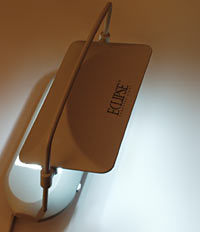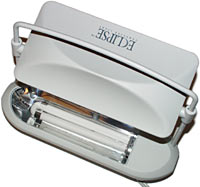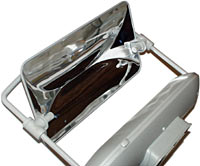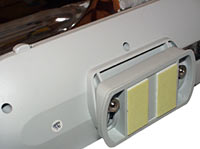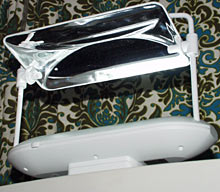
Eclipse Computer Light
Review date: 18 May 2001.Last modified 03-Dec-2011.
Staring all day at anything close to your face isn't very good for you.
Staring all day at a computer monitor can be even worse.
A lot of computers are ergonomic disaster areas. The keyboard's at the wrong height, the monitor's off to one side, the chair's lousy, and the user hasn't a clue about how to make things better. It's now hard to find a mouse, keyboard or monitor that doesn't come with an ergonomics info sheet that firmly declares that not following its recommendations is practically certain to lead to consequences up to and including spontaneous human combustion. But lots of people pay little attention.
Which is fine, if you're not someone who spends a lot of time using a computer. Or if you're just one of the lucky ones who can type eight hours a day while sitting on an apple crate with their elbows tied together and walk away afterwards, year after year, without so much as an ache or pain.
That's not the way to bet, though. If you spend a lot of time at your PC, it pays to put things in the right places and learn healthy habits.
Computer room lighting's been a problem for ages. Things are getting better, now, but the light setup in a lot of computing environments is still lousy.
If your room's lit, as most are, by fittings hanging from the ceiling, you'll be wanting to set up your monitor so that you don't see reflections of the lights in it. The flat screens on many modern monitors (like the excellent Samsung I review here) help, because they reflect less of the room behind you. And anti-reflective screen coatings are getting better and better too. But lots of office workers still just can't avoid seeing one or more ceiling fluoros reflected in their screen.
A good anti-reflective coating can reduce most such reflections to annoyance level only. But if you can see lights reflected in your screen, you can probably also directly see lights over the top of your monitor. Direct line of sight, or minimally darkened reflected line of sight, to light sources is going to give you glare problems.
Glare happens when there are small things in your field of vision that are much brighter than the general scene. Such small light sources can't be handled well by your irises; your eyes' pupil size is matched to the overall scene illumination, and so small light sources will appear really bright and draw lines on your retinas. The more of them there are, and the brighter they are, the more work your eyes end up doing and the sooner they'll get tired.
Indirect lighting solves this problem. Indirect lights don't point straight at the thing you want lit. Instead, they point at a reflector, usually a wall or the ceiling, and the light that bounces off the reflector does the work of lighting the area. It's impossible to look straight at the light source itself.
The result is a nice wide diffuse field of illumination that won't give you glare problems, and won't cast sharp shadows either.
Indirect lighting is less efficient than direct - you lose a lot of intensity when you point your lights at the walls - but that's about the only reason not to like it.
The One Tech Eclipse Computer Light is an indirect lighting gadget for your computer work area, made to sit on top of your monitor.
There's a standard PL-13W folded fluorescent tube in the base of the Eclipse, behind a removable clear plastic lens. It therefore shines upward...
...at the adjustable reflector, which can be tilted fore and aft, and slid up and down on the plastic frame that doubles as a carry handle.
You get further adjustment potential from the design of the Eclipse's base. It's got a couple of strips of double-sided tape for attachment to the top of your monitor, and it can be tilted back and forth, which allows you to further customise the Eclipse's light distribution.
Setting up
The Eclipse light I got for review is an American 110 volt 60 Hertz unit. Here in 220/240V 50Hz Australia, you can easily operate low power American appliances that don't care about the AC frequency difference - the Eclipse, like most gadgets, doesn't. But you have to use a step-down autotransformer from a place like Jaycar Electronics.
A hundred watt autotransformer - which is more than enough capacity to run the Eclipse, whose plugpack power supply has a 36 watt peak rating - will still cost you $AU40, though. And autotransformers come with so many warnings that more timid users, and penny-pinchers, will probably very much prefer to wait for a version of the device in question that'll run directly from their local power.
Fortunately, One Tech have a 220/240V Eclipse in the pipeline; it's apparently due around September this year.
It's not just a matter of swapping plugpacks. The Eclipse has a small-heavy-plug-in-lump power supply, but that plugpack contains the ballast for the fluorescent lamp, so it's not an off-the-shelf item.
The ballast has to be in the plugpack, because if it were in the lamp itself it'd probably interfere with the image on your monitor. The setup instructions tell you not to put the plugpack very close to your screen.
Assuming you live somewhere where you can plug the Eclipse straight into the wall, setup is pretty easy. You just have to stick the thing to the top of your monitor, turn it on, and fiddle with the base and reflector angle until the lamp lights what you want it to.
Using it
With the Eclipse mounted on top of my monitor, it wasn't easy to find a position for the reflector that didn't give me line of sight to the direct reflection of the lamp. Which is bad. I eventually managed it, but more light than I wanted was shining onto the screen, so I had to unstick the Eclipse and move it back a bit.
I had this problem because my monitor's not positioned ideally. A monitor should be positioned so that you look slightly down at the screen. The top edge of the display should be at eye level. But the oddities of my gimcrack homebuilt computer desk mean that the middle of my screen is at eye level. It's not an ergonomic nightmare, but it's not the way you're meant to use the Eclipse. Boosting myself up to the right monitor viewing angle solved the problem.
If you've got a setup like mine, or something even worse, there's no rule of the universe that says an Eclipse has to be put on top of a monitor. You could put it on a shelf to one side of your workstation, for instance. Actually, the range of adjustment the base and reflector give you would even let you attach the thing to a suitably painted wall, sticking out horizontally, and still get a nice even light over the area below.
The double sided tape that holds the Eclipse down is only good for a few re-stickings, but there's nothing stopping you from peeling it off and replacing it with a couple of fresh pieces as you experiment with different placement options.
A lot of light escapes around the Eclipse's reflector. It lights the wall behind the monitor and the ceiling above it quite well. It's not like a conventional Luxo-type lamp, which directs practically all of its light output in the direction it's pointed.
So it won't let you turn your desk into one little island of brightness in a darkened home or office. But if you want to use the Eclipse as your only light, you can; the light spill gives you dim illumination of a whole ordinary-sized room.
An interesting side effect of the adjustable Eclipse design is that it makes it easy to light your face brightly, for webcam purposes. Webcams all have lousy sensitivity and give a nasty grainy image in normally lit night-time rooms; truly is it said that You Can't Have Too Much Light For Video.
Angling the Eclipse reflector so the maximum amount of light hits your face will, of course, turn the Eclipse into a quite major glare source and cause deceased ergonomicists to spin in their graves. But compared with the interrogation-room feeling you get if you point a normal desk lamp at your face, it's pretty mild. And it does give you a cleaner video picture.
One thing that impressed me about the Eclipse's light was its tonal quality.
Most fluorescent lights today are the "triphosphor" type made for maximum efficiency at minimum cost. The output adds up to white, but looked at through a spectroscope (or the cheap version - the refraction rainbow on a CD, which can actually be used as the basis of a rather good proper spectroscope) reveals itself as a few narrow bands of colour, with big gaps where a proper broad-spectrum illuminator has output. Incandescent lamps have broad-spectrum output; most fluoros don't.
What this means is that things that are some colour which a lamp doesn't emit will not look right in its light. There are no photons of the right frequency available to bounce off the item in question and let you know what colour it really is. Shine a red light on a green thing and it'll seem to be black.
What the heck am I talking about, here? Well, take a look at an example.
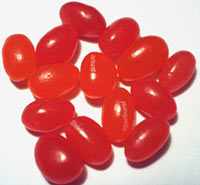
Some orange and pink Starburst jelly beans. They look much the same, don't they?
That's because they're lit, in this picture, by my compact fluorescent (CFL) room light. The CFL doesn't emit a broad enough spectrum to make the colour difference obvious. It only has one orangish-red phosphor, so things like these jelly beans that have colours in that area of the spectrum come out looking very similar.
The CFL also has a quite low "colour temperature"; its output is a very yellowish white. I've adjusted my digital camera's white balance to compensate for this; the human brain does white balance adjustment unconsciously., This is why indoor night-time no-flash film photographs tend to look a lot yellower than you remember the scene being.
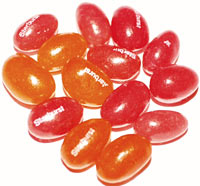
When I pop up my nice broad-spectrum camera flash, suddenly the difference becomes as obvious as it ought to be.
Yes, I know it's somewhat overexposed. That's because I'm not willing to take up many minutes of my day photographing jelly beans, OK?
The Eclipse's lamp is not a cheap triphosphor one; it's a nice full-spectrum unit, and it lets me tell my jelly beans apart. It's actually got a 6400 Kelvin colour temperature rating, which makes it a "daylight" lamp with a pretty clean bluish-white output.
The spectral difference between the Eclipse and the CFL in my ceiling fixture is huge. When I used only the Eclipse to light the room for a while, then switched to only the CFL, I felt as if I'd just put on contact lenses that'd been hanging in a bacon smokehouse for three weeks. The effect faded as my brain compensated for the new lighting bias, but the room still looked dim.
Now, my 20 watt CFL is considerably brighter than the Eclipse - the Eclipse lamp rating is only 13 watts, and the triphosphor CFL is more efficient too, so it's probably got easily twice the Eclipse's light output. But the room nonetheless looked more colourful and generally pleasing when I lit it with the Eclipse - and, of course, my actual work area was lit more brightly, because that's where a big slice of the Eclipse's output goes.
The Eclipse's PL-13W lamp, by the way, is a standard item, not an oddball proprietary unit. You can buy replacement PC-13Ws from One Tech, but you should also be able to get them from any lighting shop.
The PL-13W is rated for a respectable 10,000 hour life. So unless you leave your Eclipse on all day, the tube should last a few years.
Getting one
You can buy an Eclipse light from One Tech's order page here for $US49.95 plus shipping. Various other places stock them as well; ThinkGeek has them for $US39.99, for instance. There's no distributor here in Australia yet; after the Eclipse that works on 240V comes out, that may change.
By fancy-lamp standards, the Eclipse isn't very expensive. OK, for the price of the all-plastic Eclipse you can get a funky adjustable-arm halogen desk lamp made of metal. But the Eclipse still looks nice, and it works better than direct-illumination lamps.
Overall
The Eclipse light isn't an amazing, mind-blowing revelation. If your computer area's decently lit already - if you already have no glare problems, in other words - it won't make a huge difference.
High colour temperature lighting is quite nice, if you ask me, but lots of people like warm yellow light better. Only graphic design types who want printed matter to look like the on-screen version really need to worry about their room light's colour temperature and colour rendering.
For the money, though, this is a great product. It won't cure eyestrain all by itself; if you peer at a screen for a living, some degree of eyestrain is just something you have to live with. But if glare is a problem for you, an Eclipse seems very likely to help. It works, and it works well.
Recommended.
